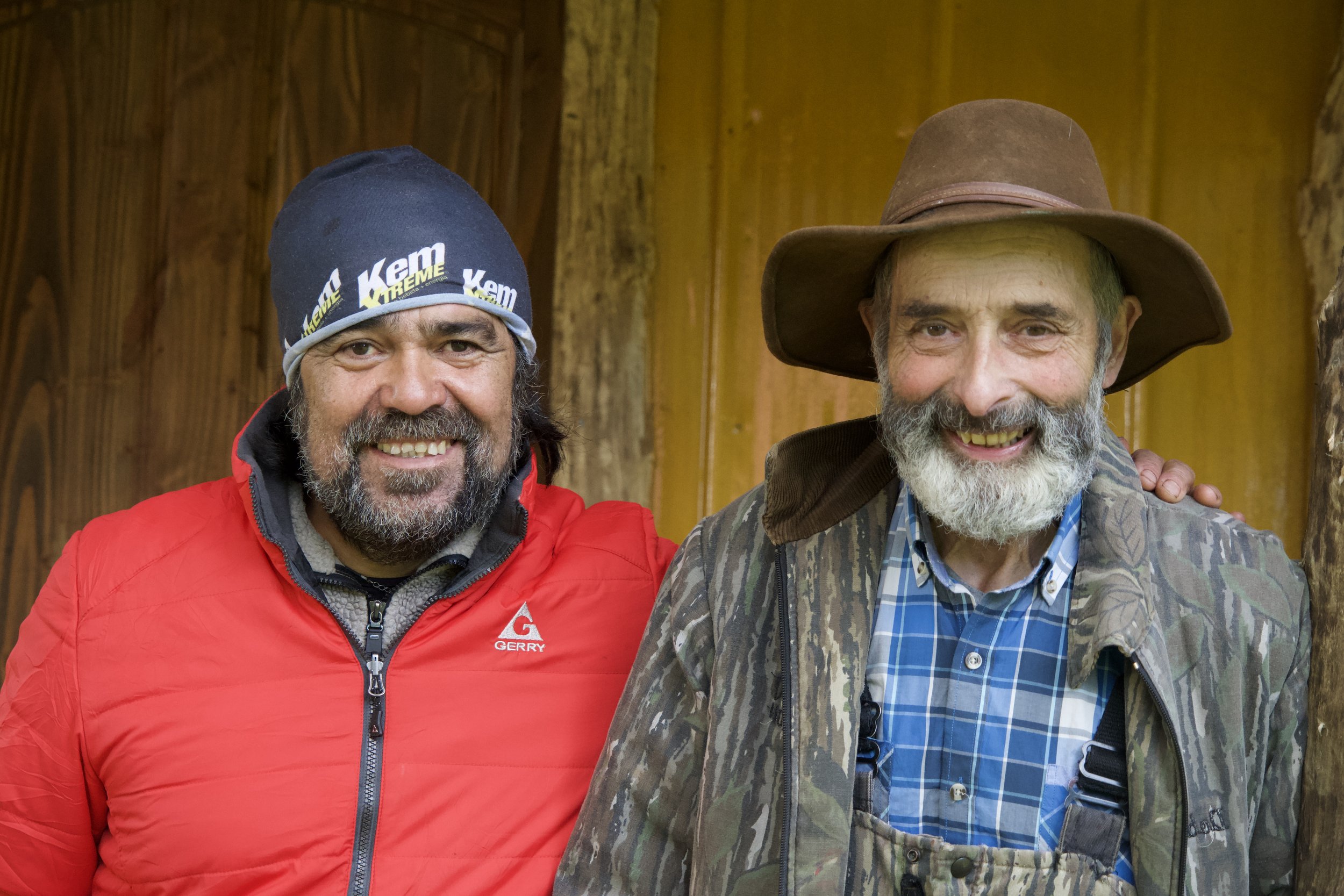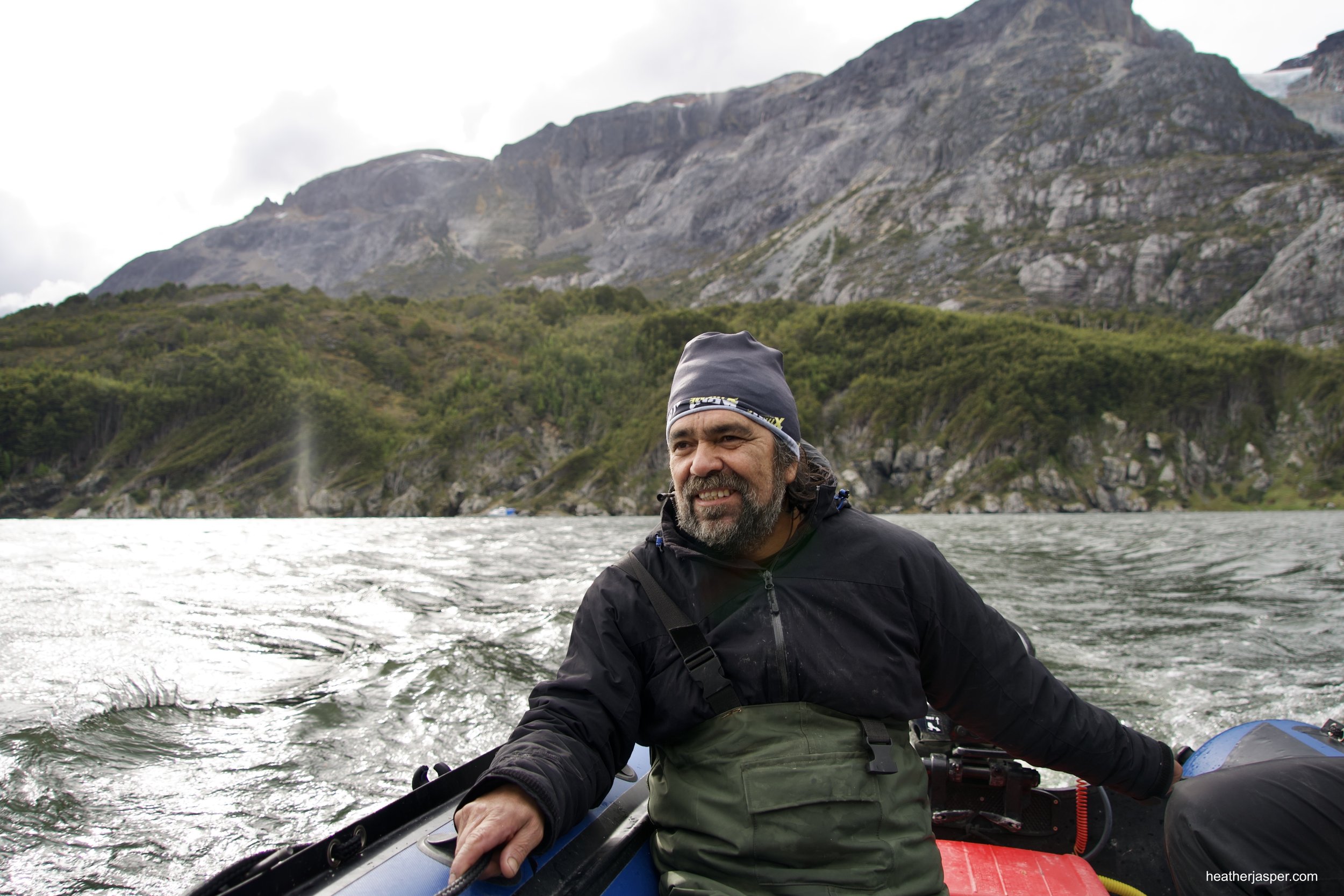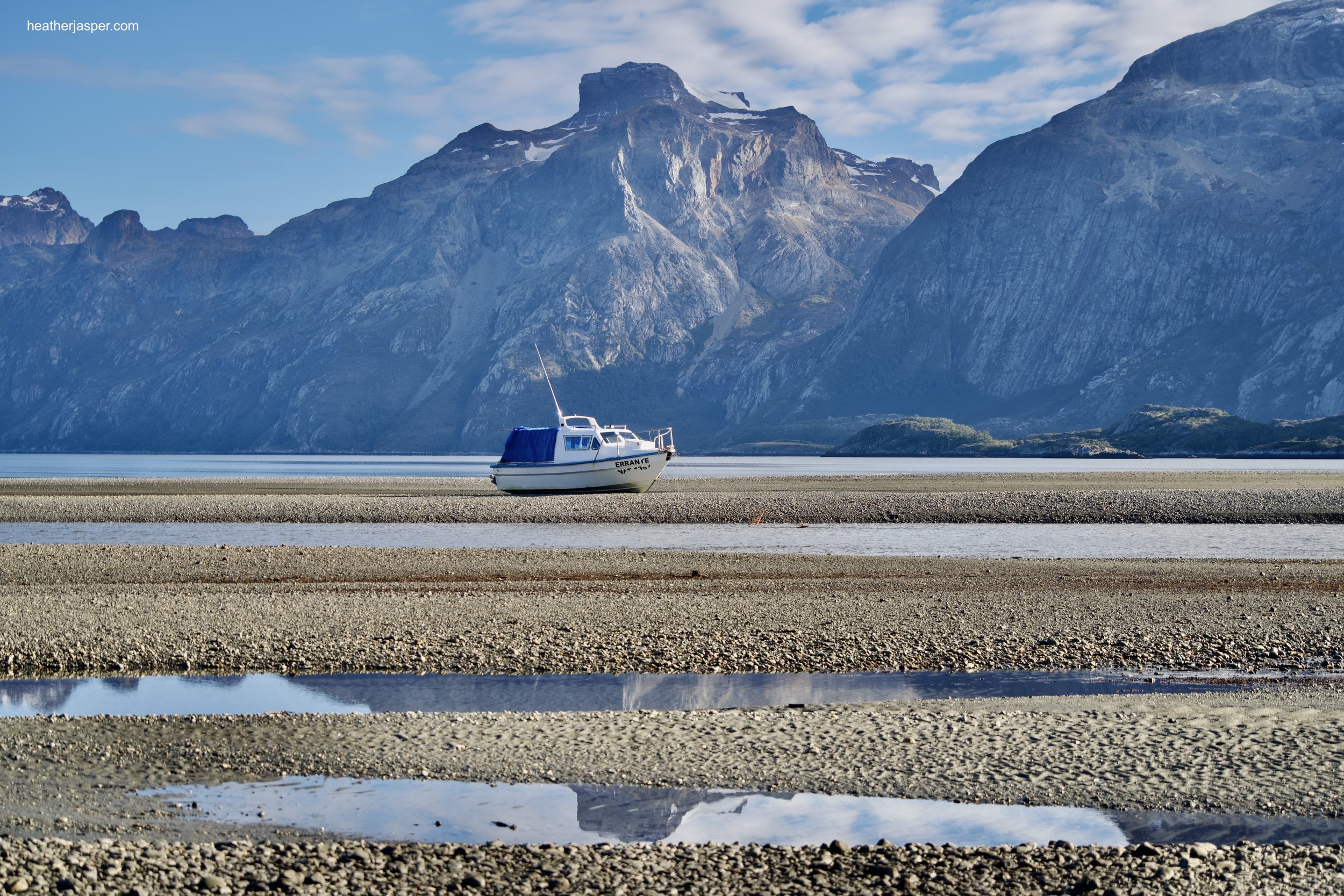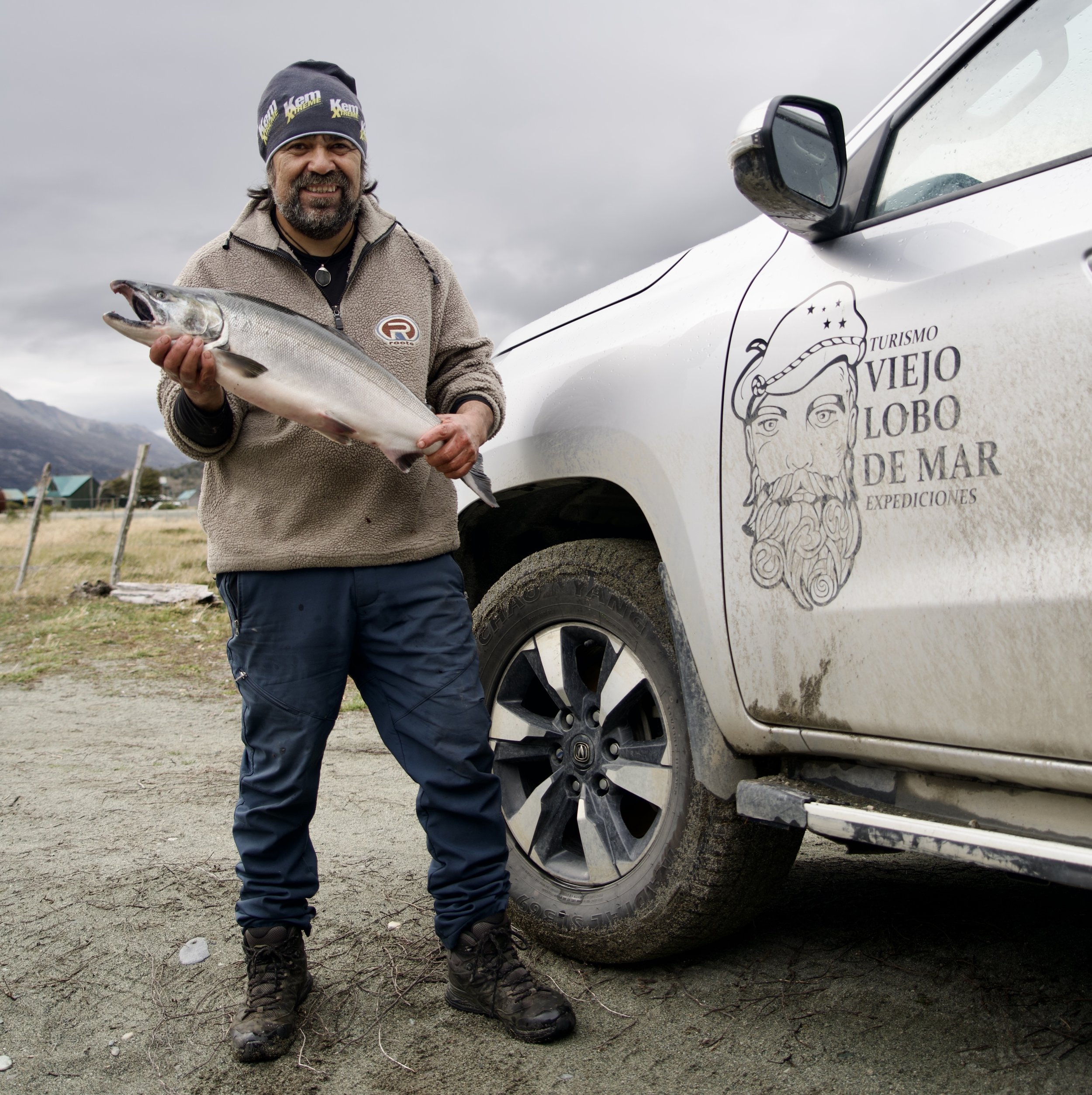Chile: Fishing at the End of the Earth
Juan Bahamondes’ boat points out into Almirantazgo Fjord, ready for tourists to come visit the elephant seals.
“The wolf ate that fish’s head.”
“The elephants live very close to here.”
Juan Bahamondes speaks of wolves and elephants as if we were on a different continent. He lives on the Almirantazgo Fjord on the southern coast of Tierra del Fuego, which is home to both sea lions and elephant seals. Sea lions are wolves in Spanish: lobo de mar.
The “wolves” are Bahamondes’ best friends and arch-nemesis at the same time. He named his guiding agency Viejo Lobo de Mar, after the sea lions that keep him company and steal the fish from his net. His father grew up as a fisherman on the island of Chiloé, fishing from a sailboat, though the Bahamondes family moved to Tierra del Fuego when Juan was a child.
He has a wide smile and a twinkle in his eyes that you would expect from Santa Claus. At 57, his beard is salt and pepper, but he has a wild mane of black hair that he keeps tamed under a stocking cap. His hands are strong from decades of fishing and seem impervious to both cold and heat. He pulls his fishing net from the ice-cold sea as easily as he takes flaming branches from the fire to put in the bottom of his DIY smoker, where he makes phenomenal smoked salmon.
Bahamondes’ home is a small camper trailer parked near the beach of Caleta María, which means Mary’s Cove in Spanish. Half of a Chilean flag flies from a driftwood mast above Bahamondes’ outdoor shed. The wind has shredded the other half. Wind is a constant in Patagonia. The northern half of Tierra del Fuego is a bare, windswept plain with a few scrubby plants and grasses. It takes several hours driving south from the town of Porvenir to see any trees. Bahamondes is the only resident in Caleta María.
Most travelers arrive on the Chilean side of Tierra del Fuego via the ferry from Punta Arenas, usually to visit the King Penguin colony two hours south of Porvenir. Another two hours south of the King Penguins is Pampa Guanaco, the last outpost of the Chilean police. There is a small government clinic and a one-room schoolhouse, which had six children in six different grades when I visited. Another two hours south of Pampa Guanaco is Caleta María, at the end of the road. The closest grocery store and gas station are in Porvenir. Caleta María is so isolated from the rest of Chile that the only radio Bahamondes can listen to is from Argentina.
Caleta María, with its population of one, attracts up to a dozen tourists a day in the summer months from November to February. The elephant seal colony in the neighboring bay draws people, as do the glaciers dotted along the Almirantazgo Fjord. There are tiny islands with nesting colonies of albatross and other marine birds. In the austral autumn, March and April, sport fishers from around the world come to fish the fall salmon run.
Bahamondes is worried about what will happen when Chile finishes a road that passes Caleta María on its way to Chile’s southernmost city of Puerto Williams.
“The government should do an impact study to see how many tourists Caleta María can support before the road is finished,” says Bahamondes. “The ecosystem here is very delicate and we don’t have any studies about how to maintain it when the road brings mass tourism.” The road is projected to take another ten years, so there is plenty of time if the government undertakes the study.
“Too many beautiful places have been ruined by unregulated tourism,” worries Bahamondes. He attended the World Ecotourism Summit in Québec in 2002 and again in Norway in 2007, where he learned about strategies for managing tourism that are being used around the world. Unfortunately, he hasn’t seen the Chilean government apply any of those strategies to Tierra del Fuego.
His trip to Québec was also formative in his attitude towards language learning. When he first started to work with tourists in 2001, he took online courses to learn English. The trip to Québec changed that. In the Miami and Boston airports, he reports he was told to speak English so rudely that he became disheartened. He decided if Americans wouldn’t try to understand his Spanish when he was a visitor in their country, he wouldn’t put so much effort into learning English for people who visit his country.
Since then, Bahamondes has worked with tourists who speak French, Polish, Japanese, Bulgarian, Norwegian and many more. He has found that communicating with gestures, drawings and pantomime is very effective and a lot more entertaining than trying to speak English with all of them. Language isn’t a barrier for Bahamondes, whose love of the sea and marine animals shines through, regardless.
Bahamondes with his friend and neighbor Germán Genskowski, one of the first homesteaders in the region.
Bahamondes is the most social hermit I’ve ever met. He welcomes visitors with arms spread wide, showing in any language that the traveler is welcome. With the same gesture, he greets his friends and neighbors with a hearty bear hug. He may live like a hermit, so far from any town, but he loves company and is very close with his neighbors, the Genskowskis. The Genskowski family homestead is only half an hour away, heading north towards Pampa Guanaco.
Caleta María provides Bahamondes with the best of both worlds. He has a stunning view of an entire mountain range, complete with glaciers and towering waterfalls. His home at the end of the road is as peaceful as a place could be, though the same tranquility that he loves also attracts visitors from all over the world. The week I was there, he received a family from southern France and a group from northern Chile, even though the tourist season was almost over. Some come for his tours to the elephant seals and glaciers. Some, like me, just come to see how far south they can get. Bahamondes stays in his camper by the sea, meeting people from all over the globe.
He has a deep-seated belief that all people are created equal and says that he doesn’t treat powerful politicians any differently than backpackers who hitchhike to Caleta María. Bahamondes is trusting, friendly and generous. He happily takes most of his catch to share with friends, fileting and cleaning the salmon before he leaves.
Bahamondes’ wife and children live in Porvenir, where his daughter helps manage his tour agency, Viejo Lobo de Mar Expediciones. The lack of cell service in the far south means that Bahamondes’ only communication source is a satellite-based Garmin In-Reach, which can only handle messages of 160 characters. His daughter manages his social media presence and relays reservations, weather forecasts and other information to him, 160 characters at a time.
“It’s only half an hour to the elephant seals,” Bahamondes explained to me when I arrived. “Their bay is just around that corner,” he points across the bay to the north. “I cleaned it recently, so it looks nice. Wind and water currents take all the sea trash from the area right to their beach. I have to clean it several times a year.”
It was a perfectly still morning when he took me to see the elephant seals. I could hear them before I could see them. Their loud snorts, sighs, and grunts echoed across the glassy water. The beaches where they live are strewn with large driftwood and from a distance it’s hard to tell which are logs and which are seals.
We got close enough that I could tell the elephant seals were watching us, but I was still relieved the sea was calm so I could use my binoculars. Nearby, along a rocky section of shore, two males were battling. They can weigh up to 5,000 pounds (2,300 kg) and I could feel the vibrations through the water as they crashed into each other. Every battle ended in one sinking its teeth into the neck of the other. Both had necks scarred from hundreds of battles.
If you know where to look, the cold, clear water is home to king crab.
Before we returned to Caleta María, Bahamondes took me to another rocky area where we sat still, leaning over the sides of the zodiac to spot king crab on the ocean floor. The water is crystal clear, but he still spotted the crabs before I did every time. Next was a tour around an island where albatross nest.
“Can you see that some of the nests still have juveniles in them?” Bahamondes asked. “They should have all left by now. I wonder if the warmer weather has confused them.”
The changing climate has brought something new to Caleta María: rain. According to Bahamondes, it never used to rain so far south. Any precipitation was always hail or snow. The days I was there, it rained almost half the time.
“I love this place, and it’s hard not to worry about it. Between the changing climate and the road they’re building, there’s a lot at stake here. It’s not just the sea either,” he adds. “There are endangered peat bogs here that are important carbon sinks.”
“The people who come here now are people who really want to be here. It takes at least four hours to get from the airport in Punta Arenas to Porvenir. Then they have to drive over four hours, over rough roads from Porvenir. They have to plan to be so far from any town, from restaurants, lodging and gas stations. When the road is completed south of here to Puerto Williams, Caleta María will only be two hours from an airport.”
For now, the wildness of Calera María and the Almirantazgo Fjord is still intoxicating. In November, an orca pod usually comes through. Last November, Bahamondes saw a female orca kill a sea lion and feed it to her calf. That wildness is what he wants to protect the most. It’s the lack of regulations that worries him.
“There aren’t any laws against jet skis here,” Bahamondes says, shaking his head. “For now, this is so far from anywhere that nobody brings jet skis. What will happen when they finish the road? Will the orcas still come if people start using jet skis here? If there are hundreds of tourists rather than dozens? Will the albatross still nest here? Will the elephant seals stay?”
When I asked why him why he is so committed to Caleta María, Bahamondes doesn’t hesitate.
“Here, nature tells you how to live.”
Viejo Lobo de Mar Expediciones
Contact Viejo Lobo de Mar for boat tours to elephant seal colonies, glaciers and more. Email vldmexpediciones@gmail.com and Instagram @viejolobodemar_ or Facebook @vldmexpediciones








